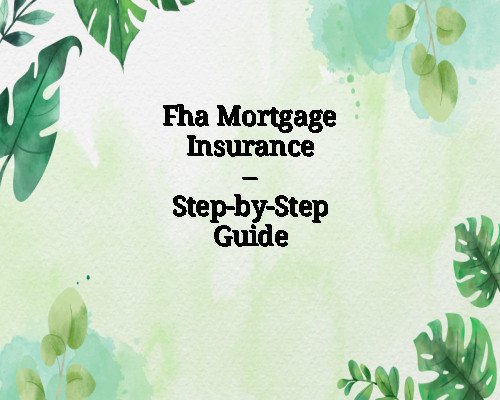FHA Mortgage Insurance – Step-by-Step Guide
Understand FHA mortgage insurance in detail, including upfront and annual premiums, how it works, and how to reduce or remove it to save on your loan.
What Is FHA Mortgage Insurance?
Federal Housing Administration (FHA) mortgage insurance is a protection plan that secures lenders against borrower default. It allows buyers with lower credit scores or limited savings to qualify for a mortgage with a smaller down payment. However, this comes at the cost of mandatory mortgage insurance premiums (MIP).
FHA mortgage insurance is required for all FHA loans and includes two key components:
-
Upfront Mortgage Insurance Premium (UFMIP)
-
Annual Mortgage Insurance Premium (MIP)
Understanding these components and how they work is essential for budgeting and managing the cost of your FHA loan effectively.
Why FHA Mortgage Insurance Is Required
FHA loans are government-backed, which reduces the risk for lenders. Because these loans are offered to borrowers with lower credit scores or higher debt-to-income ratios, the FHA requires mortgage insurance to mitigate risk and sustain its insurance fund. This setup makes homeownership accessible to more people but adds to the total cost of the loan.
Step-by-Step Guide to FHA Mortgage Insurance
Step 1: Determine If an FHA Loan Is Right for You
Before committing to FHA mortgage insurance, determine if an FHA loan suits your financial profile. It’s often ideal for:
-
First-time homebuyers
-
Those with credit scores between 580–679
-
Buyers with limited down payment funds (as low as 3.5%)
-
People with higher debt-to-income (DTI) ratios
If you have a higher credit score or more savings, consider comparing FHA with conventional loans, which may offer better terms without long-term insurance requirements.
Step 2: Understand the Upfront Mortgage Insurance Premium (UFMIP)
FHA borrowers must pay an Upfront Mortgage Insurance Premium at closing. This is a one-time fee of 1.75% of the loan amount.
Example:
For a $250,000 loan, UFMIP = $4,375
This amount can be:
-
Paid in full at closing
-
Rolled into the total loan balance
Many borrowers choose to finance it, which slightly increases their monthly payments.
Step 3: Understand the Annual Mortgage Insurance Premium (MIP)
The Annual MIP is paid monthly as part of your mortgage payment. The cost varies depending on:
-
Loan amount
-
Loan term (15 or 30 years)
-
Loan-to-value ratio (LTV)
Typical MIP rates for a 30-year loan with a 3.5% down payment:
-
Loan < $726,200: 0.55% annually
-
Loan > $726,200: 0.75% annually
Example:
Loan = $250,000
MIP = 0.55% = $1,375/year = $114.58/month
The MIP is recalculated each year based on your remaining loan balance.
Step 4: Know How Long You’ll Pay MIP
MIP isn’t always forever, but how long you pay it depends on your down payment:
-
Down payment < 10%: MIP lasts for the life of the loan
-
Down payment ≥ 10%: MIP lasts for 11 years
If you want to stop paying MIP sooner, you’ll need to refinance into a conventional loan once you build up at least 20% equity.
Step 5: Estimate Total FHA Mortgage Insurance Costs
To budget correctly, calculate the total cost of UFMIP and annual MIP over time.
Example:
Loan: $250,000
UFMIP: $4,375
Annual MIP (first year): $1,375
10-year total (assuming no refinance): ~$17,125 in MIP + $4,375 UFMIP = $21,500
This cost can significantly impact your total loan expense, so understanding it is critical.
Step 6: Make Your Down Payment Work for You
A larger down payment can shorten or reduce your MIP obligation. Consider:
-
Saving for a 10% or higher down payment to limit MIP to 11 years
-
Using down payment assistance programs or gift funds if available
A bigger down payment not only shortens your insurance timeline but may reduce your monthly MIP cost.
Step 7: Explore Refinancing to Remove FHA MIP
If your home gains value or you’ve paid down a significant portion of the loan, consider refinancing into a conventional mortgage:
Benefits:
-
No private mortgage insurance (PMI) if equity is ≥ 20%
-
Potentially lower interest rate
-
Save thousands in MIP over the life of the loan
Requirements:
-
Good credit score (typically 620+)
-
Stable income
-
20% equity in your home
Refinancing is one of the most effective ways to eliminate FHA mortgage insurance and reduce monthly expenses.
Step 8: Monitor Changes in FHA MIP Policy
The FHA periodically reviews and updates MIP rates. Stay informed by checking HUD announcements or talking to your lender about changes that could affect your mortgage.
Recent changes have included MIP reductions to increase affordability for new borrowers. If such changes apply to you, they can help lower your monthly costs without refinancing.
Pros and Cons of FHA Mortgage Insurance
Pros
-
Enables homeownership with a low down payment
-
Accepts lower credit scores than conventional loans
-
Fixed rates and predictable terms
-
Insurance allows lenders to offer better loan terms
Cons
-
MIP adds significantly to long-term cost
-
MIP duration depends on down payment
-
Can’t remove MIP without refinancing (if < 10% down)
-
Reduces equity growth due to added costs
Tips to Reduce the Cost of FHA Mortgage Insurance
-
Boost your credit score: Better scores qualify you for refinancing faster.
-
Make extra mortgage payments: Build equity more quickly.
-
Avoid late payments: On-time payments help with refinancing eligibility.
-
Refinance when possible: Once your equity is at 20%, move to a conventional loan.
Final Thoughts
FHA mortgage insurance is a critical component of FHA loans, offering access to credit for buyers who might not qualify elsewhere. While it adds costs, knowing how to manage, reduce, or eliminate it strategically can help you save money over time. Always run the numbers and speak with a qualified mortgage professional to tailor your strategy.

